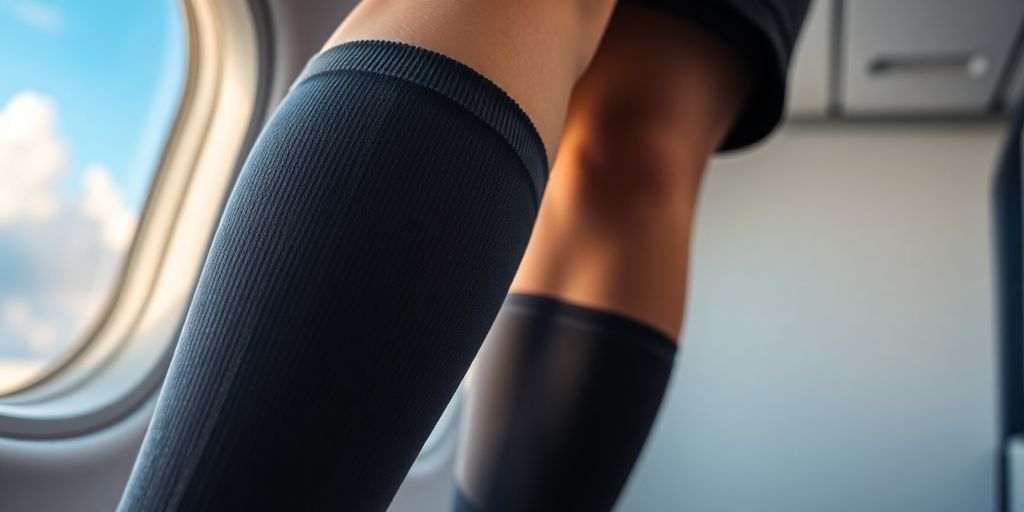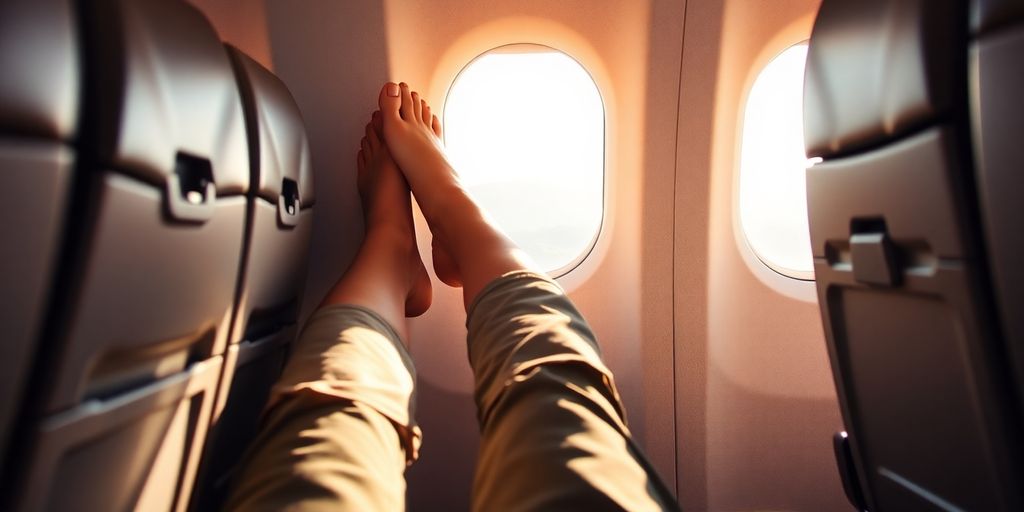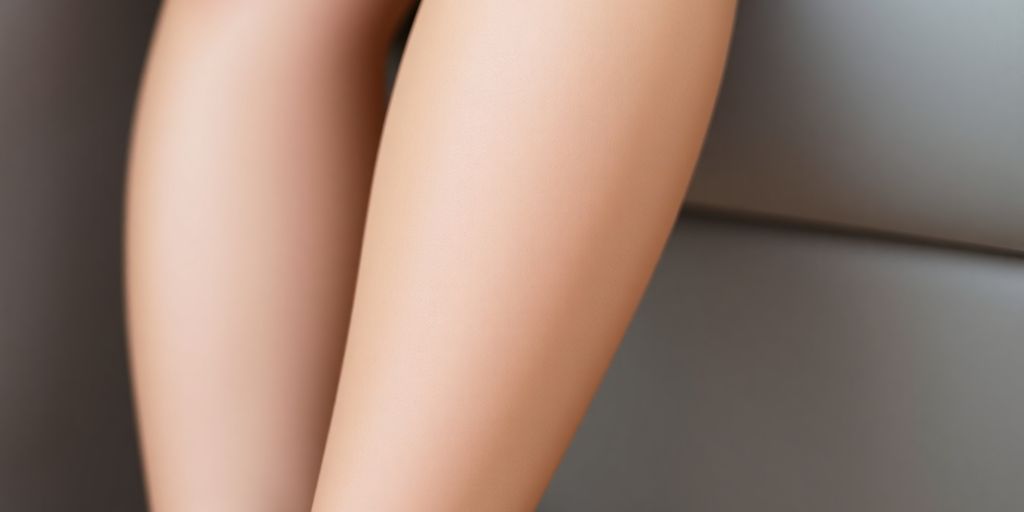Getting ready for a flight usually means thinking about tickets, luggage, and maybe what book to read. But have you ever thought about what your legs are doing up there? Long flights can be tough on your body, especially your legs and circulation. That's where compression socks for flying come in. These aren't just regular socks; they're designed to help your blood flow better and keep your legs feeling good. This guide will walk you through how to pick the best compression socks for flying so your next trip can be a lot more comfortable.
Key Takeaways
- Compression socks help stop leg swelling and discomfort during flights.
- Wearing compression socks can lower the risk of serious blood clots (DVT) on long trips.
- The right compression socks keep your blood moving well, which is important when you're sitting still for hours.
- Look for socks with the right compression level (measured in mmHg) and made from materials that breathe.
- Make sure to get the correct size; a good fit is key for compression socks to work properly.
The Importance of Compression Socks for Flying
Flying can be tough on your legs. Sitting for hours, especially on long flights, can lead to all sorts of problems. That's where compression socks come in. They're not just a fashion statement; they're a real health tool for travelers. Let's break down why they're so important.
Reducing Leg Swelling and Discomfort
Ever get off a plane and feel like your ankles have disappeared? That's swelling, and it's super common. Compression socks help minimize this by gently squeezing your legs, which prevents fluid from pooling. It's like giving your legs a little hug that keeps everything moving. Plus, less swelling means way more comfort during and after your flight. No one wants to start their vacation with achy, swollen legs!
Preventing Deep Vein Thrombosis (DVT)
Okay, this one's a bit more serious. DVT is when blood clots form in your deep veins, usually in your legs. It can be dangerous if a clot breaks loose and travels to your lungs. Flying increases the risk because you're sitting still for so long. Compression stockings can help prevent blood pooling, which reduces the risk of DVT. It's a simple step that can make a big difference, especially if you're on a long-haul flight or have other risk factors.
Enhancing Blood Circulation During Flights
Think of your blood circulation like a highway system in your body. When you're sitting for hours, that highway gets congested. Compression socks act like traffic cops, keeping things flowing smoothly. They gently squeeze your legs, encouraging blood to move back up towards your heart. This improved circulation not only reduces swelling and the risk of DVT but also helps you feel more energized and less fatigued after your flight. It's like giving your circulatory system a little boost when it needs it most.
Wearing compression socks on a flight is like giving your legs a mini-workout while you sit still. They help keep your blood flowing, reduce swelling, and lower the risk of blood clots. It's a simple way to take care of your health while traveling.
Key Characteristics of Effective Compression Socks for Flying
Optimal Material Composition for Comfort
When it comes to compression socks, the material makes a huge difference. You want something that's breathable and won't make your legs sweat like crazy during a long flight. A blend of synthetic fibers like nylon and spandex is often a good bet, offering both elasticity and durability. Natural fibers such as merino wool or bamboo are also great because they're soft and have moisture-wicking properties. Avoid materials that trap heat and moisture, as this can lead to discomfort and even skin irritation.
Understanding Compression Levels (mmHg)
Compression levels are measured in mmHg (millimeters of mercury), and it's important to pick the right level for your needs. For flying, you'll typically want something in the 15-20 mmHg or 20-30 mmHg range. These levels provide enough pressure to support blood flow without being too constricting. If you have existing medical conditions, it's always best to check with your doctor to see what compression level they recommend. Don't just grab the tightest pair you can find – more compression isn't always better!
Proper Length and Fit for Maximum Benefit
Length and fit are super important. Knee-high socks are generally the way to go for flying because they cover the entire calf, which is where a lot of blood pooling happens. Make sure you measure your calf circumference and follow the manufacturer's sizing chart. The socks should feel snug but not painfully tight. If they're cutting off your circulation or leaving deep marks, they're too small. If they're sliding down, they're too big. Getting the right fit ensures that the stylish compression socks do their job properly and keep your legs feeling good.
Considering Design and Aesthetics
Okay, let's be real – nobody wants to wear ugly socks. Luckily, compression socks have come a long way in terms of design. You can find them in all sorts of colors, patterns, and styles. So, while the primary function is to support your health, there's no reason you can't pick a pair that you actually like. Choose something that matches your personal style and makes you feel good. After all, if you like how they look, you're more likely to wear them!
Wearing compression socks on a flight can really make a difference. They help keep your blood flowing, reduce swelling, and prevent that heavy, tired feeling in your legs. It's a simple way to take care of yourself during air travel.
Selecting the Right Compression Socks for Your Flight

Choosing the correct compression socks for your flight isn't just about grabbing any pair off the shelf. It's about understanding your needs and matching them to the sock's features. Let's break down the key considerations to ensure you pick the perfect pair for a comfortable and healthy flight.
Matching Compression Level to Your Needs
The compression level, measured in mmHg (millimeters of mercury), is a critical factor. It dictates how much pressure the socks apply to your legs. For most travelers, mild to moderate compression (15-20 mmHg) is usually sufficient. However, if you have pre-existing conditions like varicose veins or a history of DVT, you might need a higher level (20-30 mmHg), but it's best to consult with your doctor first. Think of it like this: everyday use calls for a gentle hug, while specific medical needs require a firmer one.
Choosing Breathable and Moisture-Wicking Materials
Material matters, especially on long flights. You want something that keeps your feet dry and comfortable. Look for these features:
- Breathability: Materials like merino wool, bamboo, or synthetic blends with moisture-wicking properties are ideal. They allow air to circulate, preventing your feet from getting sweaty and uncomfortable.
- Moisture-Wicking: This feature pulls sweat away from your skin, keeping your feet dry and reducing the risk of blisters or skin irritation.
- Durability: The material should be able to withstand repeated wear and washing without losing its compression or shape.
Imagine being stuck on a long flight with socks that make your feet feel like they're in a sauna. Not fun, right? Breathable, moisture-wicking materials are your best defense against that scenario. They keep your feet feeling fresh and comfortable, even after hours in the air.
Ensuring Accurate Sizing for a Snug Fit
Proper sizing is non-negotiable. Socks that are too tight can restrict circulation, while socks that are too loose won't provide the necessary compression. Here's how to get it right:
- Measure Your Calf: Use a soft measuring tape to measure the widest part of your calf. Do this in the morning, before any swelling occurs.
- Consult the Sizing Chart: Each brand has its own sizing chart, so don't assume your size is the same across all brands. Use your calf measurement to find the corresponding size on the chart.
- Consider Length: Knee-high socks are generally recommended for flying, as they cover the entire calf and provide optimal support. Make sure the length is appropriate for your leg to avoid discomfort or bunching.
Who Benefits Most from Compression Socks for Flying
Travelers on Long-Haul Flights
If you're settling in for a flight that's going to last several hours, compression socks are definitely something to consider. Sitting for extended periods can really mess with your circulation, and these socks can help keep things moving, reducing the risk of swelling and discomfort. Think of it as a little bit of self-care for those long journeys. I always pack a pair in my carry-on for anything over 4 hours.
Individuals Prone to Swelling or DVT
Some people are just more likely to experience swelling in their legs and feet, or are at a higher risk for deep vein thrombosis (DVT). If you fall into this category, compression socks aren't just a nice-to-have, they're pretty important. Conditions like pregnancy, obesity, or a history of blood clots can increase your risk. It's always a good idea to chat with your doctor, but compression socks can be a simple way to help manage these risks during air travel.
I have a friend who swears by them because she tends to get really bad swelling when she flies. She says it makes a world of difference in how she feels when she lands.
Anyone Seeking Enhanced Comfort During Air Travel
You don't need to have a specific medical condition to benefit from compression socks. Even if you're generally healthy, they can make your flight more comfortable. They can help prevent that heavy, tired feeling in your legs after a long flight. Plus, with so many styles and colors available now, you can even find some that look pretty good. Why not add a little extra comfort to your next trip? It's a small thing that can make a big difference. You can find medical-grade options if you want to be extra careful.
Maximizing the Benefits of Your Compression Socks for Flying

So, you've got your compression socks ready for your next flight. Great! But simply wearing them isn't enough. To really get the most out of them, there are a few things you should keep in mind. Let's dive into how to maximize those benefits.
When to Wear Your Compression Socks
Timing is everything. For the best results, put on your compression socks first thing in the morning, before any swelling has a chance to start. This way, you're proactively preventing fluid buildup rather than trying to reduce it after the fact. Keep them on throughout the entire flight and even for a few hours afterward, especially if it's a long one. Think of it as giving your legs a continuous support system. Don't wait until you're already feeling the discomfort; be prepared!
Caring for Your Compression Socks
Taking care of your socks will extend their life and maintain their effectiveness. Here's a simple routine to follow:
- Wash them after each use. This prevents the buildup of bacteria and keeps the fabric fresh.
- Use a mild detergent and avoid bleach, which can damage the elastic fibers.
- Air dry them instead of using a machine dryer. The heat can degrade the compression over time.
- Replace them every 6-12 months, or sooner if you notice they're losing their elasticity. A worn-out sock won't provide the support you need.
Proper care ensures your compression socks continue to deliver the intended benefits. Treat them well, and they'll treat your legs well in return.
Consulting a Healthcare Provider for Specific Needs
While compression socks are generally safe for most people, it's always a good idea to chat with your doctor, especially if you have any underlying health conditions. They can provide personalized recommendations based on your specific needs and medical history. For example, if you have severe circulatory issues, your doctor might suggest a specific compression level or type of sock. It's better to be safe than sorry, so don't hesitate to seek professional advice.
Different Types of Compression Socks for Flying
Graduated Compression Socks Explained
Graduated compression socks are designed to apply the most pressure at the ankle, with the pressure gradually decreasing up the leg. This helps encourage blood flow back towards the heart, fighting the effects of gravity during long periods of sitting. They're the most common type you'll find and are generally recommended for flying. The idea is to counteract the pooling of blood in your lower legs that can happen when you're stuck in a seat for hours. They come in different compression levels, so it's important to pick the right one for your needs.
Over-the-Counter vs. Medical-Grade Options
You'll find compression socks in drugstores and online, but there are also medical-grade options that require a prescription. The main difference lies in the level of compression. Over-the-counter socks typically offer mild to moderate compression, usually between 15-20 mmHg, which is often enough for most travelers. Medical-grade socks, on the other hand, can go much higher, offering 20-30 mmHg or even more. These are usually prescribed for specific medical conditions like lymphedema or severe venous insufficiency. For flying, mild compression socks are generally sufficient and can be purchased over the counter or online.
Choosing the Right Type for Your Journey
Selecting the right compression sock involves considering several factors:
- Compression Level: Match the mmHg to your needs. For most flights, 15-20 mmHg is fine. If you have pre-existing conditions, talk to your doctor.
- Material: Look for breathable, moisture-wicking fabrics like nylon, spandex, merino wool, or bamboo. This will keep your feet comfortable during the flight.
- Length: Knee-high socks are usually best, as they cover the entire calf.
- Fit: Make sure to measure your calf circumference and follow the manufacturer's sizing chart. The socks should feel snug but not too tight.
It's a good idea to try on different types of compression socks before your trip to see what feels most comfortable. Consider the length of your flight and any pre-existing conditions you might have. If you're unsure, it's always best to consult with a healthcare professional to get personalized recommendations.
There are also anti-embolism stockings, which provide uniform pressure and are geared towards those who are not moving a lot or recovering from surgery.
Conclusion
So, there you have it. Adding compression socks to your travel bag can really make a difference, especially on those longer flights. They help keep your blood moving and stop your legs from feeling all puffy and tired. Just remember to pick a pair that fits right, feels good, and has the right amount of squeeze. With so many options out there now, you can totally find some that look good too. A little planning goes a long way to making your next trip way more comfortable and less stressful on your legs.
Frequently Asked Questions
Why should I wear compression socks when flying?
Compression socks gently squeeze your legs, helping blood flow better and stopping swelling. This is super helpful when you're sitting still for a long time on a plane, as it keeps your blood moving and lowers the chance of clots.
What level of compression is right for air travel?
For most flights, socks with a pressure level between 15-30 mmHg are best. This range gives enough squeeze to help your blood without being too tight or uncomfortable.
What length of compression sock is best for flights?
Knee-high socks are usually the best choice for flying. They cover your whole calf, which is important for good blood flow. Make sure they fit snugly but aren't too tight.
What materials should I look for in compression socks?
Look for socks made from materials like nylon, spandex, merino wool, or bamboo. These materials are good because they stretch, last a long time, and help keep your legs dry and comfy by wicking away sweat.
Who should wear compression socks for flying?
Anyone flying, especially on long trips, can benefit. They're also great for people who often have swollen legs or are worried about blood clots. Basically, if you want to feel better and safer during your flight, these socks are for you.
When should I wear my compression socks during a flight?
It's best to put them on before you get on the plane and keep them on for the whole flight. After your trip, take them off and wash them as directed to keep them in good shape.




Share:
Understanding Edema: A Comprehensive Guide to Swelling
Finding Lasting Chronic Venous Insufficiency Relief: A Comprehensive Guide